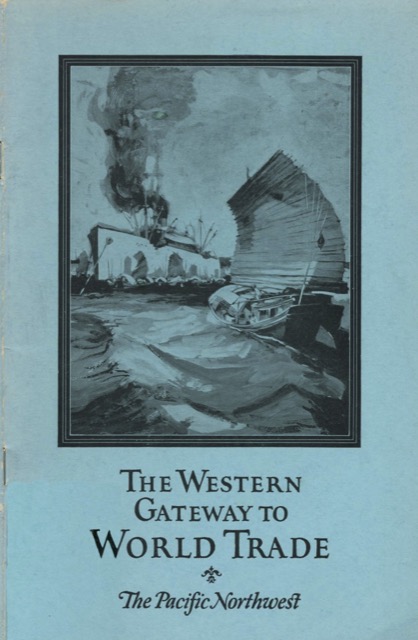The introduction to this 1924 booklet, which I scanned from the Spokane Public Library collection, notes that it is the eighth of the series of pamphlets published by the Burlington Route, Great Northern, and Northern Pacific railways “as part of a national campaign to inform the people of the United States about the Pacific Northwest—Montana, Wyoming, Idaho, Oregon and Washington—and to aid in its sound development.” We’ve already seen one of these booklets, Through the American Wonderland, promoting the region’s scenery. Others focused on timber, water power, poultry farming, minerals, and other industries.
 Click image to download a 12.1-MB PDF of this 36-page booklet.
Click image to download a 12.1-MB PDF of this 36-page booklet.
This one, published in 1924, deals with the shipping industry, focusing on the ports of Seattle and Portland. The booklet notes that, when measured by value, Oregon and Washington ports shipped more goods in 1922 than those of California. Of course, a large portion of the goods shipped to or from Northwest ports spent part of their journeys on Great Northern or Northern Pacific trains.

I see the word “builded” has shown up again in this booklet. Must have something to do with what was considered high falutin’ writing in the 20’s.
Morning has come and gone for most Northwest ports, and afternoon is slowly turning into dusk. Seattle is a mere shadow of itself as a port while Tacoma has grown. San Francisco has ceased to be a port of any significance while Oakland has expanded tremendously. None of the ports can hold a candle to the ports of Los Angeles and Long Beach, the largest in terms of trade on the entire Pacific coast. The difference is the large ports of today recognized the importance of containerized cargo while San Francisco and Seattle continued thinking finger piers and breakbox cargo would go on forever. It didn’t, and it’s too late for those two formerly great ports to regain a toehold. The line about the 400 million Chinese just waiting to make things cheaper than we could make them here was prescient though. I’m sure the authors in 1924 never imagined the rise of the largest store in the world (Walmart) selling billions of dollars of goods every year made in China.
Jim